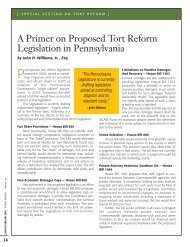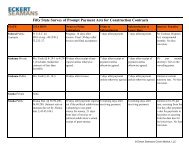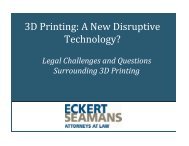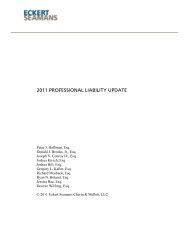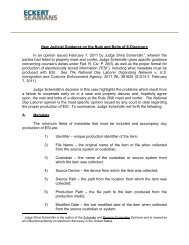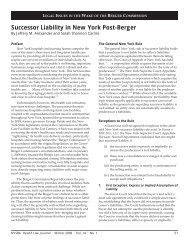nurses deviating from applicable standard of care, where neurosurgeon rarely practiced inhospital setting, he could not remember the last time he interacted with nurses in specialcare, he never published anything regarding nursing, and he never practiced internalmedicine or read journals on the topic).7. Two Schools of ThoughtIn those medical malpractice actions in which there is evidence of conflicting schools ofthought concerning the proper mode of treatment, Pennsylvania courts traditionally hold that aphysician’s decision to use one recognized mode of treatment, rather than another accepted modeof treatment, cannot serve as the basis for a finding of negligence. Jones v. Chidester, 610 A.2d964 (Pa. 1992); Levine v. Rosen, 616 A.2d 623 (Pa. 1992); Sinclair v. Block, 633 A.2d 1137 (Pa.1993). In Jones, the court noted, “[t]he proper use of expert witnesses should supply theanswers. Once the expert states the factual reasons to support his claim that there is aconsiderable number of professionals who agree with the treatment employed by the defendant,there is sufficient evidence to warrant an instruction to the jury on the ‘two schools of thought.’”Jones v. Chidester, 610 A.2d at 969. The court further opined that, at that point, the questionbecomes one for the jury who must decide, “whether they believe that there are two legitimateschools of thought such that the defendant should be insulated from liability.” Id.In Gala v. Hamilton, 715 A.2d 1108 (Pa. 1997), the Pennsylvania Supreme Court ruledthat defendants in medical malpractice cases do not need medical literature to receive a “twoschools of thought” jury instruction. Rather, defendants are able to meet their burden ofestablishing the alternative “school of thought” as legitimate with expert testimony alone.In Choma v. Iyer, 871 A.2d 238 (Pa. Super. Ct. 2005), the Superior Court held that thetrial court had erred in giving the jury the “two schools” instruction and that this error requiredgrant of a new trial. The case involved reconstructive surgery after a mastectomy, and thequestion presented at trial was whether the TRAM flap procedure performed on Plaintiff wasappropriate given her obesity and medical history. Based on Plaintiff’s expert testimony that thisprocedure was contraindicated and Defendant’s expert testimony to the contrary, the trial courtruled that the “two schools of thought doctrine” applied.The Superior Court disagreed, stating that the doctrine did not apply because both parties’experts agreed that the TRAM flap procedure was not appropriate for a patient that is extremelyobese, and it was a disputed question whether Plaintiff fell into the extremely obese category.The court ruled that “[w]here…the dispute is not to the course of treatment, but rather to aquestion of fact regarding plaintiff’s condition, the ‘two schools of thought’ doctrine isinapplicable.” Id. at 241. What existed in this case did not present divergent opinions on how totreat the patient, just different assessments of her pre-surgery condition with respect to the extentof her obesity. It was for the jury to decide if Plaintiff met the criteria of being extremely obese.If she did, all experts agreed the procedure performed was the wrong one. Because the doctrinedid not apply, and the improper “two schools” instruction given to the jury may have contributedto the verdict in favor of Defendant, a new trial on negligence was required.In Reger v. A.I. duPont Hospital for Children of the Nemours Foundation, 259 Fed.Appx. 499 (3d Cir. 2008) (not precedential), Plaintiffs brought a medical malpractice action42
against Defendants after the death of their son. At trial, Plaintiffs’ expert testified that there wasonly one way to perform the procedure at issue. Defendants presented multiple experts, whotestified that there were other acceptable approaches to perform the procedure. As a result, thedistrict court submitted the “two schools of thought” charge to the jury.On appeal, the Third Circuit affirmed. The court held that the “two schools of thought”charge was appropriate. The court explained “[w]hen a physician chooses between appropriatealternative medical approaches, harm which results from physician’s good faith choice of oneproper alternative over the other, is not malpractice.” Id. at 3.In Barr v. Beck, No. 99-16065, 2011 Pa. Dist. & Cnty. Dec. LEXIS 287 (Pa. Com. Pl.Feb. 3, 2011) (Trial Order), affirmed without opinion, 2011 Pa. Super. LEXIS 3729 (Pa.Super. Ct. July 25, 2011), the Plaintiff contended that the foundational requirement for a“two schools of thought” instruction had not been met. Citing Jones v. Chidester, the courtstated that “[t]he well-established case law clearly and unequivocally obligates a physicianonly to present evidence that his or her method ‘is advocated by a considerable number ofrecognized and respected professionals.’” The court further stated that the “PennsylvaniaSupreme Court has refused to quantify the number of professionals who must accept themethod.” Id. (citing Jones v. Chidester, 610 A.2d at 969) (“[W]e do not attempt to place anumerical certainty on what constitutes a ‘considerable number.’”. Rather, the courtnoted that a more flexible approach should be used, where “an expert witness who providesfactual reasons to support his claim that there is a considerable number of professionalswho agree with the treatment employed by a defendant physician ‘suppl[ies] the answers’and, hence the necessary foundation for the instruction on the ‘two schools of thought.’”Id. (citing Jones v. Chidester, 610 A.2d at 969).C. Causation – Medical MalpracticeIt is also necessary that the plaintiff prove by a preponderance of evidence that the breachof duty was the legal cause of the injury. While this sounds simple enough, it is far morecomplicated.1. Reasonable CertaintyIn order to establish the element of proximate cause, the plaintiff first has the burden ofestablishing, with a “reasonable degree of medical certainty,” that the injury in question didresult from the negligent act alleged. McMahon v. Young, 276 A.2d 534 (Pa. 1971). Experttestimony fails to meet this reasonable certainty requirement in a medical malpractice actionwhen the Plaintiff’s expert testifies that the alleged negligence possibly caused or could havecaused the Plaintiff’s injury, that such negligence could very properly account for the injury, oreven that it is very highly probable that Defendant’s negligence caused the poor result. Hreha v.Benscoter, 554 A.2d 525 (Pa. Super. Ct. 1989) (citing Kravinsky v. Glover, 396 A.2d 1349,1355-56 (1979)), appeals denied, 569 A.2d 1367 (Pa. 1989), 571 A.2d 383 (Pa. 1989). Similarly,testimony that a doctor “more likely than not” deviated from the standard of care, and that theplaintiff “more likely than not” suffered harm as a result, is insufficient to state a prima faciecase of medical malpractice. Corrado v. Thomas Jefferson Univ. Hosp., 790 A.2d 1022 (Pa.Super. Ct. 2001). In determining whether an expert testified to the requisite degree of medical43
- Page 3 and 4: EMTALA CASES ......................
- Page 5: Filing an Affidavit of Non-Involvem
- Page 8 and 9: II.PROFESSIONAL LIABILITY - AN OVER
- Page 10 and 11: The Superior Court reversed the tri
- Page 12 and 13: to a third party pursuant to the st
- Page 14 and 15: After approximately five months, De
- Page 16 and 17: learned the day after the surgery t
- Page 18 and 19: conduct to the delay in colon cance
- Page 20 and 21: court admitted the expert’s testi
- Page 22 and 23: (b)(c)other reasonable causes, incl
- Page 24 and 25: corroborated his testimony. The cou
- Page 26 and 27: husband’s estate. Plaintiff alleg
- Page 28 and 29: Other notable federal cases arising
- Page 30 and 31: The Superior Court found that in re
- Page 32 and 33: § 1303.512(b). The court, however,
- Page 34 and 35: In Neidig v. United States, No. 07-
- Page 36 and 37: Additionally, the Supreme Court not
- Page 38 and 39: were not indicated for her conditio
- Page 40 and 41: surgeon is the same as it would be
- Page 42 and 43: It should be noted that the Superio
- Page 44 and 45: Finally, the court held that the tr
- Page 46 and 47: The Supreme Court of Pennsylvania r
- Page 50 and 51: certainty, the court reviews expert
- Page 52 and 53: Under Pennsylvania law, the Court n
- Page 54 and 55: testimony, Defendant presented his
- Page 56 and 57: Following Cooper v. Roberts, 286 A.
- Page 58 and 59: Plaintiff developed chronic diarrhe
- Page 60 and 61: where payment is made by Medicaid w
- Page 62 and 63: accomplished. In Valles v. Albert E
- Page 64 and 65: In 1980, the Pennsylvania Superior
- Page 66 and 67: Plaintiff had a routine monitoring
- Page 68 and 69: Plaintiff’s Contract ClaimsThe Co
- Page 70 and 71: is a failure to report changes in a
- Page 72 and 73: unit to assure post-surgical patien
- Page 74 and 75: sliced his wrist and arm with a raz
- Page 76 and 77: licensed professionals for whom the
- Page 78 and 79: (c)Limitations of Corporate Neglige
- Page 80 and 81: Even more recently, our Superior Co
- Page 82 and 83: (a)HMO IssuesIn McClellan v. Health
- Page 84 and 85: affidavit submitted by Defendants o
- Page 86 and 87: treatments while at VA’s faciliti
- Page 88 and 89: [s]ubstantively, we believe that a
- Page 90 and 91: The party claiming the benefit of t
- Page 92 and 93: deprive (him) of civil rights guara
- Page 94 and 95: found that the District Court was w
- Page 96 and 97: With respect to fraudulent concealm
- Page 98 and 99:
would be applied in situations wher
- Page 100 and 101:
they had not raised them in the cou
- Page 102 and 103:
(a)Informed ConsentUnder MCARE, a p
- Page 104 and 105:
civil enforcement provisions and ma
- Page 106 and 107:
MCARE also changes the manner in wh
- Page 108 and 109:
whose death, in 2005, was allegedly
- Page 110 and 111:
vicariously liable if the plaintiff
- Page 112 and 113:
health center or its equivalent or
- Page 114 and 115:
In Pennsylvania Medical Society, th
- Page 116 and 117:
to any professional who is alleged
- Page 118 and 119:
Since the 2005 amendments, there ha
- Page 120 and 121:
ule, but who intentionally ignores
- Page 122 and 123:
the original Complaint was delivere
- Page 124 and 125:
foreclose all challenges against th
- Page 126 and 127:
number of boxes), which was support
- Page 128 and 129:
questions of professional judgment
- Page 130 and 131:
deviated from any professional stan
- Page 132 and 133:
The Third Circuit affirmed the Dist
- Page 134 and 135:
claims and cross-claims remain agai
- Page 136 and 137:
By an Amendatory Order dated March
- Page 138 and 139:
The court acknowledged that there i
- Page 140 and 141:
apply and that the trial court misa
- Page 142 and 143:
Barbados had enough litigation-spec
- Page 144 and 145:
E. Preemption of Vaccine Design Def
- Page 146 and 147:
2. Pa. R. Civ. Pro. 1036.1 - Reinst
- Page 148 and 149:
Barrick, at *34-35.Furthermore, the
- Page 150 and 151:
(b) the utility of the defendant’
- Page 152 and 153:
2006). In this case, Plaintiffs bro
- Page 154 and 155:
B. Elements of a Cause of Action fo
- Page 156 and 157:
decision in Muhammad precluded Mr.
- Page 158 and 159:
considered speculative “only if t
- Page 160 and 161:
underlying cause of action involved
- Page 162 and 163:
In Capital Care Corp., the Superior
- Page 164 and 165:
The court found, however, to state
- Page 166 and 167:
of reasonable diligence. The standa
- Page 168 and 169:
not be set aside. On July 7, 2005,
- Page 170 and 171:
complete bar to recovery. Since a l
- Page 172 and 173:
On appeal, Plaintiffs claimed that
- Page 174 and 175:
In Liggon-Redding, 659 F.3d at 265,
- Page 176 and 177:
elieved of those minimum standards
- Page 178 and 179:
elevant to the proceedings, the com
- Page 180 and 181:
establish professional misconduct b
- Page 182 and 183:
Upholding the Superior Court’s Or
- Page 184 and 185:
Id.Rejecting revocation and suspens
- Page 186 and 187:
order as a sanction under Rule 4019
- Page 188:
{1009912]182




